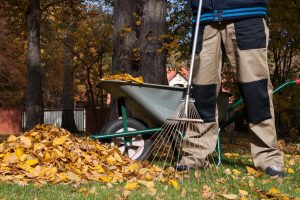Even after the hot and sunny days of summer are past, your lawn still needs care before the autumn days turn colder and shorter. Your grass and garden plants are getting ready for their winter nap, but your work is not yet done. Make sure those plants are healthy when spring comes again. When you properly prepare for fall, your plants’ root and nutrient-gathering systems are protected throughout the harsh Mid-Atlantic winter months, and you can rest easier in springtime when those first buds begin to form. Here are some essential fall lawn care tips to get New Jersey homeowners, landscapers, and gardeners for the colder months.
 Cleanup Time
Cleanup Time
Start out by cleaning up your yard and other landscaped areas of your property before the first frost hits. As it gets cooler, trees lose their leaves, and wind and rain storms will bring down branches and twigs. This lawn debris is like a magnet for insects and pests. Leaving it on the lawn will kill your grass in short order. Instead, make sure you engage in two important activities.
Rake Your Leaves
Remove the leaves from your lawn, landscaping, flower gardens, and beneath shrubs. Leaves will smother your plants and grass, and they also provide a habitat for pests and insects that spread plant disease and destroy trees.
Clear Debris
Gather up all those branches, twigs, really and tree debris that scatter across your lawn. It makes your lawn look poorly maintained, and clumps of fallen twigs and brush make cozy winter homes for rodents, snakes and other critters looking for a warmer spot to spend the winter.
Keep Cutting Your Grass
It may be growing slower once fall arrives, but you still need to keep grass clipped and short for it to winter well. Even when it starts to brown, the roots are still absorbing water and nutrients from the soil to outlast the winter. Cut your lawn down to a height of about 1.5 to 2 inches tall so it is less prone to molding under snowfall. Mowing grass also prevents pests and rodents from attempting to hide in the tall grass. Short grass keeps the plants from smothering themselves when battered by rain, and the blades can absorb more sunlight before winter arrives.
Aeration: Ventilating Your Dirt
Aeration is an important part of fall lawn care a lot of people neglect. Aeration remains an essential aspect of lawn care because it loosens up the soil in your yard to keep the soil from compacting during winter freezes. If you start early enough in the fall, it will also help air, fertilizer, and water can penetrate into the ground more deeply. Aeration allows your grass and plants to absorb more oxygen, food, and moisture to see them through their dormancy. Plug aerators are best for this job, as spike aerator punch large enough holes for proper soil penetration by essential elements.
Don’t Forget About Watering!
Even though your grass’ growth is slowing down, it still needs water to live. Whether you use an automated sprinkler system or not, don’t stop taking an active role in watering your lawn as autumn sets in. Do moisture checks about every other week because the changing weather will have a significant impact on how much water is in the soil. An inch a week is a good standard to go by in New Jersey. The extra water helps your lawn stay balanced and boosts water retention over the cold winter months.
Feed The Grass: Make Sure You Fertilize
Getting plant food in the ground between September and October helps your grass live through the winter. The early fall is crucial, as your grass retain the nutrients it needs when it begins to grow again once the ground warms up. Spring growth takes a tremendous amount of energy, and the root system of your grass is essential to making sure your lawn is ready for winter.
Seed and Sod Time
As the leaves begin to turn, your lawn benefits tremendously from additional seeding even if it is still verdant and flourishing. Many species of grass only live a couple of years, so keeping your lawn seeded prevents thinning or over-running by weeds. If you plan on re-sodding, start in the early fall as the New Jersey air is cooling. Make sure to finish sodding before the first frost. Most lawn grasses seed best when the soil temperature reads between 50 and 65 degrees Fahrenheit, and they usually need a couple of weeks to build strong roots.
Ultimately, fall lawn care is about preparing your grass and plants for the winter season in New Jersey. Clear lawn debris, aerate well and don’t forget to water, fertilize and re-seed/re-sod as needed. Taking precautions during the early fall months means that when spring arrives again, your lawn will be freshly green in no time. That way, you can spend more time enjoying your yard and less time trying to bring it back to life.
Thank you for reading our blog! How can we help you? Contact us today.
